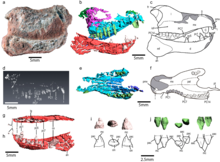| Tessellatia | |
|---|---|

| |
| Holotype cranium of Tessellatia in various views and interpretations | |
| Scientific classification | |
| Domain: | Eukaryota |
| Kingdom: | Animalia |
| Phylum: | Chordata |
| Clade: | Synapsida |
| Clade: | Therapsida |
| Clade: | Cynodontia |
| Clade: | Probainognathia |
| Genus: | †Tessellatia Gaetano et al., 2022 |
| Species: | †T. bonapartei
|
| Binomial name | |
| †Tessellatia bonapartei Gaetano et al., 2022
| |
Tessellatia is an extinct genus of probainognathian cynodont from the Late Triassic Los Colorados Formation of La Rioja, Argentina. The genus contains a single species, T. bonapartei, known from a partial skull.[1]
Discovery and naming
[edit]
The Tessellatia holotype specimen, PULR-V121, was discovered in upper layers of the Los Colorados Formation in Talampaya National Park in La Rioja Province, Argentina. The specimen consists of a partial skull, including the snout and orbital region, and lower jaws.[1]
In 2022, Gaetano et al. described Tessellatia as a new genus and species of probainognathian cynodont. The generic name, "Tessellatia", is derived from the Latin "tessella" (the individual tiles making up a mosaic), in reference to a conglomerate of basal and derived features seen in the taxon. The specific name, "bonapartei", honors the Argentine paleontologist José F. Bonaparte, who described the first cynodont fossils from the Los Colorados Formation.[1]
References
[edit]- ^ a b c Gaetano, L. C.; Abdala, F.; Seoane, F. D.; Tartaglione, A.; Schulz, M.; Otero, A.; Leardi, J. M.; Apaldetti, C.; Krapovickas, V.; Steimbach, E. (2022). "A new cynodont from the Upper Triassic Los Colorados Formation (Argentina, South America) reveals a novel paleobiogeographic context for mammalian ancestors". Scientific Reports. 12 (1): Article number 6451. Bibcode:2022NatSR..12.6451G. doi:10.1038/s41598-022-10486-4. PMC 9038739. PMID 35468982.






Well, that’s interesting to know that Psilotum nudum are known as whisk ferns. Psilotum nudum is the commoner species of the two. While the P. flaccidum is a rare species and is found in the tropical islands. Both the species are usually epiphytic in habit and grow upon tree ferns. These species may also be terrestrial and grow in humus or in the crevices of the rocks.
View the detailed Guide of Psilotum nudum: Detailed Study Of Psilotum Nudum (Whisk Fern), Classification, Anatomy, Reproduction